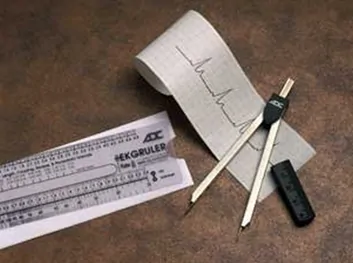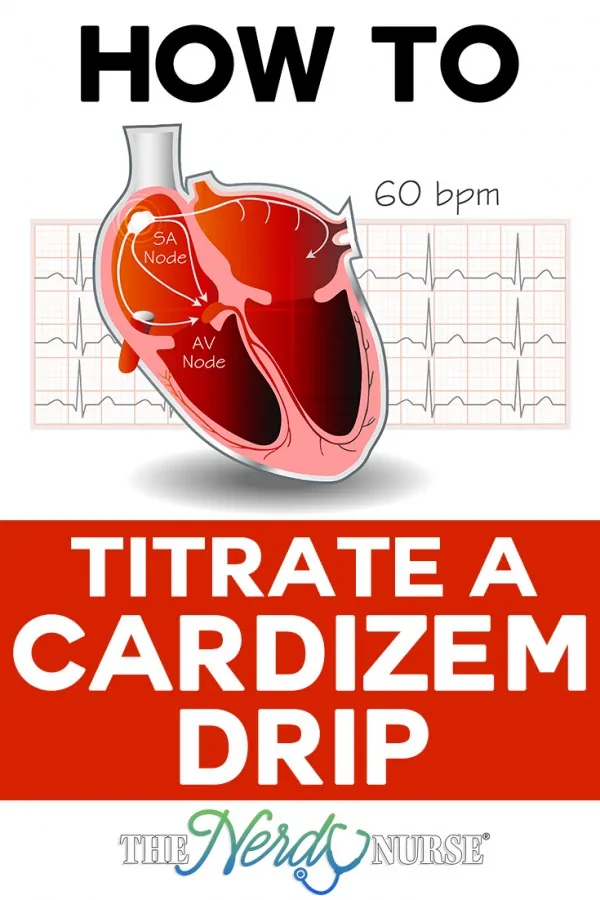Many nurses are apprehensive about having to titrate a Cardizem drip. Patients who require Cardizem are usually facing life-threatening conditions like A-fib and this can be very stressful to a nurse who doesn’t typically deal with this sort of condition. Depending on your floor there may actually be policies that state that you should transfer patients to critical care or intensive care units if they require titration on a Cardizem gtt. You should make sure that you are familiar with your facilities policy on the subject of Cardizem drips before you take responsibility for this nursing skill. The following is general information about titrating a Cardizem drip. Your employer’s policy is your source of truth. This is not medical advice.
What is Cardizem Used for and How Does it Work?
Cardizem is a medication administered for cardiac conditions. According to AdocateHealth.com:
A calcium channel blocker used to slow the ventricular rate of rapid atrial fibrillation and atrial flutter. Calcium contributes to the contraction of the heart and constriction of the arteries. Blocking the movement of calcium relaxes vascular smooth muscle (decreasing peripheral resistance) lowering the blood pressure and slowing conduction through the AV node which slows the heart rate which will reduce the work load of the heart.
When the patient sustains a rapid heart rate it could lead to an increased risk of myocardial damage (cardiomyopathy) and deterioration into ventricular fibrillation. The varying stroke volume (amount of blood pumped out of the ventricle with each contraction) decreases and causes the cardiac output to decrease. Patients will need intervention when the heart rate is over 100 and they are symptomatic.Goal of therapy:
Rate control – can be accomplished in the field with medication
Maintenance of sinus rhythm – done in-hospital
Prevention of thromboembolism – initiated in hospital with medication
Rapid atrial fibrillation is a life-threatening condition and should be handled as an emergency issue once identified.
Monitoring the Patient

Titrate According to the Heart Rate
While monitoring a patient on a Cardizem drip can be intimidating to a newbie, it’s pretty straight forward.
The initial dosing of Cardizem for A-fib/flutter might be something like the following:
Dosing (A-fib/flutter) initially 0.25 mg/kg over 2 min. If inadequate give 0.35 mg/kg over 2 min-15 min after 1st dose. Subsequent doses should be individualized. Continuous infusion: started immediately following an effective bolus dose. Initial rate= 10 mg/hr (some may respond to 5 mg/hr). If needed, may increase up to 15 mg/hr. Contraindicated: AMI, hypotension (sys<90), 2nd & 3rd degree AV block.
If the patient’s heart rate rises about the rate specified by the physician you increase the rate. If the rate dips below what you desire, you decrease the rate. Titrating Cardizem isn’t impossible, or even that hard really, you just have to know the parameters to follow. You should also monitor the patient’s blood pressure. If their systolic pressure drops below 90 then Cardizem is contraindicated.
You also have to make sure that you are paying attention to the patient and not just vital signs. If the patient tells you they feel like something bad is going to happen or that they are about to die LISTEN TO THEM!
Advocate for the Patient
Your biggest job as a nurse is to keep the patient’s best interest at heart. Even if you know how to titrate a Cardizem drip, it doesn’t mean that you should if it is putting the patient at more risk. You need to make sure you have ample resources, training, and confidence to get the job done. You also need to make sure that the patient can handle the medication, and you need to explain the medication to their patient and their families,
If the patient needs to transfer to another unit to more closely monitor their infusions, it does not mean that you are not a good nurse. On the contrary, it means that you are a good enough nurse to make sure your patients get the best care possible.
Cardiac nurses are some of the bravest and skilled nurses I know. I’ve seen CCU nurses bring patient’s back from near death through an organized ballet of V-Fib. I have personally saved a life by paying close attention to my patient’s condition and pushing a few ml of Cardizem. Whether you work in the ER, OR, ICU, CCU, Med Surg, or a long-term care facility, you have the ability to make a difference and save a life by paying attention to their needs and delivering the best nursing care possible. This means knowing how to titrate a Cardizem drip.
Master Cardiology with the Cardiac Nurse Crash Course from Fresh RN
If you’re new to a cardiac nursing or want to boost your knowledge and confidence in a cardiac-related nursing specialty, you must get the Cardiac Nurse Crash Course. It was created by prolifc writer, blogger, and speaker Kati Kleber of Fresh RN®️.
Nursing.com Academy also has a great cardiac section. If you’re looking for a comprehensive nursing knowledge base with evolving clinical content, check it out. Get a preview by downloading a few of their cardiac nursing freebies:
See also:







is there a standard for lenth of time to continue to monitor a patient following stopping a cardizem drip?
Hi Roxanne, honestly this varies by facility. So you should always refer to your facilities protocol and policy.
Thank you for the information! They just started my mom on cardizem drip. They could not get her converted and put a high tech monitor in her chest well to watch her heart rates. This is called a loop monitor. After they did the procedure the house officer wanted to discharge her I put my foot down twice. Once in ER and once after surgery as I was watching the monitor and catching abnormal runs on her monitor. Hence the cardiology team came in and they moved her to the cardiac floor. I feel they are trying to keep her going. Patient mind set is important too in wanting to live. She is in svt and afib. Thank you for the information as I head back down to the hospital I feel I can watch her more safely at bedside. It has been a while since I worked in the hospital as an RN. You never forget your core course and training.
Carol, I’m am thrilled that this info was helpful for you. Indeed, you never forget your core training, but sometimes we get out of practice on things. Keep being a great advocate for your mom!
I am looking for an example of Cardizem drip protocol to show this hospital im working at, it seems that they don’t have one and I am unable to find one please help